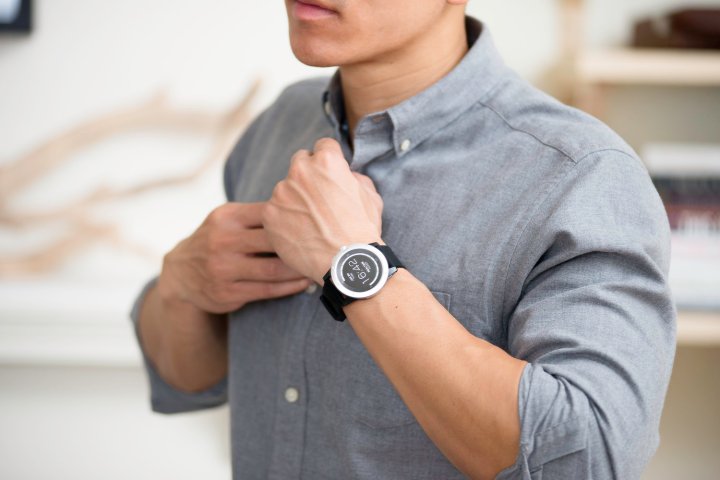
“It converts heat energy to electricity,” Akram Bokai, Matrix Industries co-founder and CEO told Digital Trends. “It works off the heat dissipated by your body.”
That’s explanation’s a little nebulous, but Bokai gave us a slightly more detailed rundown. The PowerWatch relies on something called the Seebeck effect, the same scientific principle on which NASA based the Voyager spacecraft and the Mars rover Curiosity. A temperature gradient — in this case, the difference between body temperature and the temperature of the ambient air — affects a module containing tiny semiconductors that produce a current. That current’s passed on to a converter which boosts the voltage of the collected heat energy to three volts — just enough to power the Matrix’s electronic screen.

The result is a watch that never requires recharging. “It draws very little electric current,” Bokai said. “We have the watch specced out so you never [run out of power].”
A novel charging solution isn’t the only key to the Matrix’s charge-free design. It packs what the company said is the world’s lowest-power-consuming processor, a module made by silicon fabricator Ambiq Micro. Earlier processors were too power-hungry to be effective, Bokai said — without the processor, the PowerWatch wouldn’t have been possible.
When it comes to configuring the PowerWatch, there’s not much finagling required. Slap it on and it instantly blinks to life. Take it off and your data’s stored in a memory chip powered by a 200mAh battery, which recharges using the excess energy generated by your body heat. Next time it powers up, you’ll see the correct date and preferences.
It’s an attractive design. The circular PowerWatch sports a single button responsible for launching apps like a stopwatch and sports timer. A dial navigates through screens on the smartwatch’s display. A metal grill double as a heat sink. And a four-bar power meter around the screen indicates how much energy’s reserved for the watch’s basic functions.
The PowerWatch manages to cram a veritable bounty of hardware into a low-power package. Its waterproof body, which houses a 1.2-inch monochrome LCD memory display, is machined from a solid block of aircraft-grade aluminum. And under the hood are sensors that track your sleep, record the number of steps you’ve taken over the course of a day, and measure calorie burn directly from the amount of heat your body’s generating.

That data syncs with a paired smartphone via the Matrix’s companion app, which shows you the number of calories you’ve burned, steps you’ve taken, and the restfulness of your sleep — metrics it’ll share with Google Fit and Apple Healthkit, if you happen to use either.
One of the PowerWatch’s more unique features is what Bokai calls “energy tracking.” The Matrix app shows you how much electric power you’ve produced during the day or over the course of a week, or since you first started wearing the watch. “It’s somehow really cool — that your body is producing electricity,” he said. “It could be a unique social aspect.”
PowerWatch is the product of more than five years of research, Bokai said, but wasn’t always a part of the plan. Matrix’s thermoelectric technology wasn’t intended for a smartwatch, a first. “We talked with different industries and tried to find out where we might be able to use the technology.” The more Bokai and his team dug in, though, the more they became drawn to the idea of a wearable “that you never have to recharge,” he said.
Thermoelectrics happened to be the perfect solution. “Kinetic energy works really well for resonant motion, like a motor vibrating at a specific frequency, but hand motions and steps are frequently changing so the power output’s usually low,” Bokai explained. Solar, meanwhile, has a higher power output, but requires direct sunlight — a difficult proposition for a smartwatch meant to be worn indoors.
The company’s ambitions extend beyond smartwatches, of course. It hopes to make wireless earbuds and hearing aids powered by body heat, and potentially Internet of Things products, too. “We don’t just want to be a smartwatch company,” Bokai said.
The Matrix is available with both 18mm or 20mm straps. It starts at $99 on Indiegogo, with an expected ship date of July 2017.


